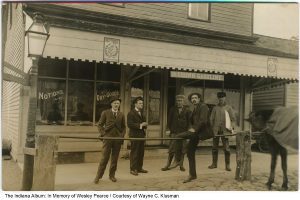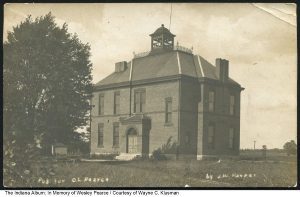
As our country was being settled and the population grew across America, many opportunities for influencing the country, community, their families, and other arose. One of those opportunities that you don’t typically find today was to influence the community by starting a town.

Wayne County, Indiana
In 1810, John Lewis’ family became the first settlers in an area northwest of Richmond in Green Township, Wayne County, Indiana. The following year several more families, including William and Sarah (Adams) Johnson, moved to the area. William and Sarah are the grandparents of Martha Johnson who married Passco Peelle, making them my 4th great grandparents. They had left their home state of North Carolina with a destination of eastern Indiana, as many others who would move to the area did over the coming years.
By 1818, signs of a community started to spring up. That year William built the first gristmill in the area. A Baptist Church gathering began about this time. Included in its early membership was Eleazer and Ruth (Davis) Smith . A few years later their daughter Rachel married William Johnson, Sarah and William’s son.
Then, around 1820, a Methodist Episcopal Church was organized. A community was forming.
Williamsburg
In 1830, William Johnson set aside some land for the creation of a town. On March 16, the town of Williamsburg was platted at a location due north of Centerville and about 3 miles south of the Baptist Church. A post office went into operation July 22.

Over the coming years, many businesses and organizations would set up operations in and around Williamsburg. The first merchant commenced business in 1831 and would be followed by many others including William’s sons Stephen and Samuel. Other businesses in the area included more gristmills, saw-mills, a slaughter house, a hotel, a train station, an ice house, wagon makers, doctors, and the First National Bank of Williamburg. The latter did not open until May 1, 1907. It is unclear if the town had any banking facilities prior to that date.
Other church organizations were formed. A Friends Meeting was also formed, but it only lasted for about 15 years before it dissolved and its members went to other nearby meetings.
In 1845, the United Brethren Church was organized. William’s son Samuel and his wife were early members of that church.
Samuel also became one of the Justices of the Peace. The area would also be the home to politicians, Masons, and Odd Fellows. As a growing community, the town also joined with others in the area to support the Union during the Civil War. Likewise, when the issue of temperance became an issue in the area, men from the surrounding area joined a debate on the subject. Clearly, each side had a lot to say as the debate started at 2 p.m. and lasted until midnight.

A Legacy
Unfortunately, William did not live to see the town take shape, as he died on August 1, only days after the post office was established. He left his wife Sarah $100 in personal property, $100 in money, the dwelling where they lived, and one quarter of the profits from the plantation where he was living. The remainder of his personal property, the mill, and the tract the mill was on was to be sold with the money divided among his heirs (Thanking him for specifically listing his children in his will, including his daughters married names.)
Sarah would live another 32 years. She maintained her own household until she was at least in her mid-80s. She died at age 97. William and Sarah are buried at the New Garden Friends Cemetery.
Williamsburg Today
Williamsburg still exists today as an unincorporated entity with a population of over 1700 people. It doesn’t have the stores and businesses it once did as travel to Richmond only takes a few minutes on modern highways. However, the post office is still in operation. It also has a community center, spiritualist church, and baseball fields.
Important Note:
Ezekiel Johnson moved to the area in 1838. He was an M.E. minister and was from New Jersey. Thus, a totally different Johnson family line in the same small town.
Featured Image Source: The Indiana Album, Wayne C. Klusman Collection https://indianaalbum.pastperfectonline.com/